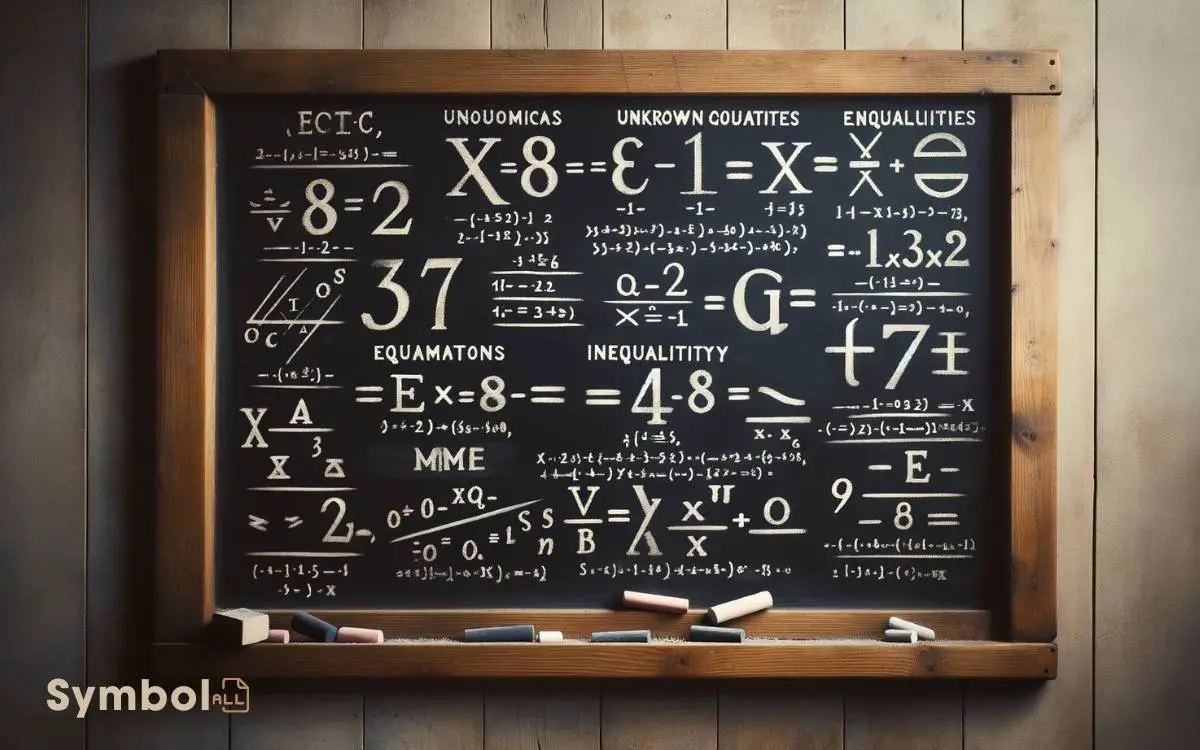20 Mathematical Symbols With Their Origin Meaning and Use
You’ll discover the fascinating origins and uses of 20 mathematical symbols, from the plus sign‘s roots in the Latin word ‘et’ to the modern adoption of the question mark (?) for expressing mathematical inquiry.
Each symbol, including the ancient multiplication cross (×) and the division obelisk (÷) introduced by Johann Rahn, has shaped how you approach problems in mathematics and beyond.
The equals sign (=), conceptualized for demonstrating equivalence, and the influential pi (π) symbol, central to geometry, are affirmations to the enduring legacy of these symbols.
They span from arithmetic to calculus, influencing fields as diverse as engineering and philosophy. Unraveling their stories offers a deeper appreciation for the language of mathematics.

Key Takeaways
20 Essential Mathematical Symbols: Origins, Meanings, and Applications
| Symbol | Name | Origin | Meaning | Use |
|---|---|---|---|---|
| + | Plus sign | Latin | Addition | To indicate the addition of two or more numbers |
| – | Minus sign/Hyphen | Latin | Subtraction | To indicate the subtraction of one number from another |
| = | Equals sign | Welsh | Equality | To show the equality of two expressions |
| / | Forward slash | Medieval Latin | Division | To represent division or fractions |
| * | Asterisk | Ancient Greek | Multiplication | To indicate multiplication, especially in computer programming |
| ^ | Caret | Latin | Exponentiation | To denote exponentiation in text-based formats |
| √ | Radical sign | Medieval Europe | Square root | To indicate the square root or nth root of a number |
| π | Pi | Ancient Greek | Ratio of circumference to diameter | To represent the mathematical constant π |
| ∑ | Sigma | Ancient Greek | Summation | To denote the sum of a sequence of numbers |
| ∞ | Infinity | Latin | Without end | To represent the concept of infinity |
| ≠ | Not equal to | 16th century Europe | Inequality | To show that two values are not equal |
| ≤ | Less than or equal to | 19th century | Comparison | To indicate that one number is less than or equal to another |
| ≥ | Greater than or equal to | 19th century | Comparison | To indicate that one number is greater than or equal to another |
| ∆ | Delta | Ancient Greek | Change / Difference | To represent change in a variable |
| % | Percent | Medieval Italian | Parts per hundred | To denote a percentage |
| ∂ | Partial derivative | 18th century | Partial differentiation | To denote a partial derivative with respect to a variable |
| ∫ | Integral sign | 17th century | Integration | To represent the integral of a function |
| i | Imaginary unit | 16th century | Square root of -1 | To denote the imaginary unit in complex numbers |
| ≈ | Approximately equal to | Modern | Approximation | To indicate that two quantities are approximately equal |
| ( ) | Parentheses | 16th century | Grouping | To group terms that should be evaluated together |
The Plus Sign (+): Evolution and Application
Though often taken for granted, the plus sign (+) has undergone significant evolution, originating from the Latin word ‘et’, meaning ‘and’, to become a cornerstone of modern mathematical notation.
Its journey from a textual conjunction to a symbol of addition reflects its adaptability and the evolving nature of mathematical communication.
You’ll find the plus sign not only in arithmetic to denote the addition of numbers but also in various scientific fields, including algebra and physics, symbolizing union and positive charges, respectively.
Its universality and simplicity make it an indispensable tool in conveying mathematical operations clearly and efficiently.
Understanding its history and application enhances your appreciation of its role in facilitating numerical and scientific discourse, underscoring the importance of symbols in achieving precision and clarity in communication.
Tracing the Minus Sign (-): History and Functionality
Just as the plus sign marks addition’s simplicity and universality, its counterpart, the minus sign (-), carries its own rich history and essential role in mathematical notation.
Originating from the Latin word ‘minus,’ meaning less, the minus sign has been a fundamental symbol for subtraction and negative values since the 15th century.
Its straightforward, horizontal line not only offers clarity in written mathematics but also signifies the operation of taking away or indicating a quantity less than zero.
Understanding its functionality is vital for grasping basic arithmetic to complex algebraic expressions.
The minus sign’s enduring presence in mathematical equations underscores its importance in facilitating clear, precise communication of ideas, allowing you to effortlessly navigate through the vast landscape of mathematical concepts.
Multiplication Cross (×): From Ancient Symbols to Modern Use
You’ll discover that the multiplication cross (×) has a rich history, tracing back to ancient civilizations where it began as a simple mark. Today, its applications have expanded, integrating seamlessly into various mathematical and technological fields.
This evolution not only highlights its enduring relevance but also underscores the symbol’s adaptability across different eras and disciplines.
Historical Roots Unveiled
Tracing the evolution of the multiplication cross (×) reveals a journey from ancient symbols to its common use in modern mathematics.
Initially, multiplication wasn’t represented by a specific symbol. Ancient mathematicians simply placed numbers beside each other or used words to signify the operation.
It wasn’t until the 16th century that the multiplication cross began to gain prominence, largely through the works of mathematicians like William Oughtred who sought a clear, concise way to denote multiplication without confusion.
The symbol itself, resembling a simplified version of the Latin letter ‘X’, was chosen for its simplicity and ease of use. This choice allowed for a universal understanding and application in mathematical equations, ensuring that the symbol’s functionality transcended linguistic barriers.
Its adoption reflects not just a mathematical evolution but a cultural consensus on the importance of clarity and efficiency in mathematical notation.
Modern Applications Explored
Today, the multiplication cross (×) serves as a crucial symbol in mathematics, seamlessly integrating into various levels of mathematical education and application.
You’ll find it’s not just limited to elementary arithmetic; it plays an essential role in algebra, physics, and even in the domains of computer science and engineering.
This cross, originating from ancient times, now facilitates the expression of complex calculations and algorithms. It’s a bridge between simple numerical operations and the representation of vector products in higher mathematics.
Additionally, in programming languages, it’s adapted for readability and functionality, ensuring that mathematical operations are clear and unambiguous.
Understanding its application across different fields enhances your ability to tackle a wide range of mathematical problems, showcasing the symbol’s versatility and enduring relevance in modern science and technology.
The Division Obelisk (÷): Origins and Usage
One frequently comes across the division obelisk (÷) in mathematical equations, a symbol with a rich history and specific applications.
Originating in the 17th century, it was popularized by Swiss mathematician Johann Rahn in 1659. Contrary to its simple appearance, the obelisk represents the concept of division, a fundamental operation in arithmetic.
It’s noteworthy that its form, resembling a dash with a dot above and below, symbolizes the division of one quantity by another.
In practice, you’ll use it to denote division in elementary mathematics, primarily before the introduction of algebraic notation where the slash (/) or fraction bar becomes more common.
Understanding its origin improves your appreciation of how mathematical notation evolves, enriching your grasp of mathematical concepts and their representation.
Equals Sign (=): The Story of Equality
The equals sign (=), a fundamental symbol in mathematics, signifies the exact equivalence between two expressions. You’re encountering a mark of balance, a concept as elegant as it’s essential.
Its story begins in the 16th century, introduced by Welsh mathematician Robert Recorde. He grew tired of repetitively writing ‘is equal to’ in his computations and sought a more efficient method.
Therefore, the two parallel lines, equal in length, were chosen to represent this mathematical truth.
This selection was no arbitrary decision; it was a deliberate reflection of the very essence of equality: what lies on one side must, without exception, mirror the other.
Since its inception, the equals sign has been central to mathematical equations, a universal language understood across cultures, a bridge between abstract concepts and concrete understanding.
The Pi Symbol (π): Unraveling Its Mystique
You’ll find that the pi symbol (π) boasts ancient origins, tracing back to civilizations that recognized the constant’s significance in geometry.
Its mathematical importance, representing the ratio of a circle’s circumference to its diameter, remains foundational in various fields of science and mathematics.
In modern use, π has transcended its numerical value to become a cultural icon in mathematics, symbolizing the endless pursuit of knowledge.
Pis Ancient Origins
Delving into the ancient origins of the pi symbol (π) reveals a narrative steeped in mathematical discovery and historical evolution. This symbol’s journey from a conceptual understanding to a universally recognized mathematical constant is fascinating.
Here’s a closer look:
- The Babylonians first approximated π over 4,000 years ago, using 3.125 as its value.
- Ancient Egyptians estimated π to be roughly 3.1605, as evidenced in the Rhind Papyrus.
- The Greek mathematician Archimedes is credited with rigorously calculating π’s bounds between 3 1/7 and 3 10/71.
- The symbol π was first used by William Jones in 1706, but it was popularized by Euler in the 18th century.
- π’s etymology traces back to the Greek word for perimeter, “perimetros”, highlighting its geometric roots.
This rich history underscores π’s integral role in the evolution of mathematics.
Mathematical Significance of Pi
Having explored π’s historical journey, let’s now examine its profound impact on mathematics and why its mystique continues to captivate scholars.
π, a constant representing the ratio of a circle’s circumference to its diameter, is indispensable in geometry, transcending mere definition. It’s the backbone of formulas calculating areas and volumes of shapes with circular bases, such as spheres and cylinders.
Beyond geometry, π’s relevance spans to trigonometry, complex numbers, and calculus, illustrating its ubiquity in mathematical analysis.
Its irrational nature, meaning it can’t be expressed as a finite decimal or a simple fraction, adds to its allure, challenging mathematicians to approximate its value with increasing precision.
This quest underscores π’s pivotal role in mathematical theory and its enduring fascination.
Pi in Modern Use
In today’s world, the pi symbol (π) permeates various fields, extending beyond mathematics to influence engineering, physics, and even digital technology. Its ubiquity isn’t just a demonstration of its mathematical significance but also to its versatile applicability.
- Engineering: Used in calculations for designing structures and analyzing mechanical systems.
- Physics: Integral in formulas that describe the natural world, including wave functions and cosmology.
- Digital Technology: Essential in algorithms for computing and digital signal processing.
- Education: A fundamental concept taught in schools worldwide, fostering a deeper understanding of geometry and trigonometry.
- Popular Culture: Celebrated on Pi Day (March 14), π has become a symbol of the beauty and mystery of mathematics.
Understanding π’s application across these domains enhances your appreciation of its central role in shaping our comprehension of the world.
Square Root (√): A Mathematical Journey
The square root symbol (√) represents a fundamental mathematical operation that reveals the number which, when multiplied by itself, gives the original value.
This symbol, rooted in ancient mathematics, has evolved over centuries into its current form. Initially, mathematicians struggled with the concept of extracting roots, grappling with the notion of what it meant to find a number that, squared, would return the original figure.
The symbol itself, a stylized ‘r’ for ‘radix’ (meaning root in Latin), was formalized in the 16th century. Its use simplifies the expression of what otherwise would be a complex operation.
Understanding the square root is important in various fields, from algebra to geometry, enabling you to solve equations and understand geometric principles with greater ease.
It’s a tribute to the elegance and efficiency of mathematical notation, bridging gaps between abstract concepts and practical application.
The Infinity Symbol (∞): Beyond the Finite
You’ll first explore the origin of the infinity symbol, tracing its roots and how it came to represent the concept of boundlessness.
Next, you’ll understand its symbolic representation, examining the depth of its meaning beyond its simple, elegant curve.
Origin of Infinity
Exploring the origin of the infinity symbol (∞), it’s important to grasp that this mathematical icon surpasses mere numeric value, embodying the concept of limitless possibilities.
The infinity symbol has a fascinating history that intertwines with mathematics, philosophy, and even spirituality.
To enhance your understanding, consider these points:
- The symbol is believed to have been introduced in the 17th century by John Wallis.
- Its shape, resembling a sideways 8, isn’t arbitrary but packed with symbolism.
- The concept of infinity existed long before the symbol, in ancient civilizations.
- Infinity’s representation has evolved, influencing various mathematical and scientific fields.
- Understanding its origin helps in appreciating its profound impact on modern thought.
Delving into its origins, you’ll find that infinity isn’t just about endlessness but a pivotal concept that challenges and expands our understanding of the universe.
Symbolic Representation Explained
Delving into the symbolic representation of the infinity symbol (∞), it’s crucial to grasp how this figure transcends traditional boundaries to embody the concept of the infinite.
Its shape, resembling a sideways figure eight, is no arbitrary design. It’s a visual representation of something without end, looping back onto itself in a perpetual cycle.
This symbol serves as a powerful metaphor in mathematics, illustrating the idea of quantities that aren’t finite. It challenges you to think beyond the usual limits, pushing the boundaries of what’s considered quantifiable.
The infinity symbol isn’t just a mathematical tool; it’s a philosophical concept, encouraging exploration into the depths of the infinite, where possibilities are limitless and conventional definitions of size and space fall short.
Practical Uses Today
In today’s world, the infinity symbol (∞) finds diverse applications, ranging from mathematical calculations to cultural representations, embodying the concept of limitless possibilities.
- Mathematics: It’s integral in calculus to denote infinite limits and series.
- Physics: Used to describe unbounded physical quantities, like the universe’s size.
- Computer Programming: Represents infinite loops or values beyond the maximum computable number.
- Graphic Design: Symbolizes eternity and continuity, prevalent in logos and branding.
- Philosophy and Spirituality: Conveys the idea of eternal life or endless cycles of rebirth.
These uses highlight the infinity symbol’s versatility, transcending its mathematical origins. It serves as a bridge between abstract concepts and practical applications, enriching various fields with its profound meaning of endlessness.
Integral Sign (∫): Calculus and Beyond
The integral sign (∫), a cornerstone of calculus, symbolizes the aggregation of parts to form a whole, offering profound insights into areas ranging from physics to economics.
You’ll find it indispensable when you’re delving into the calculation of areas under curves, volumes of solids of revolution, or solving differential equations that model physical phenomena.
This elongated S, derived from the Latin word ‘summa,’ represents the summation of infinitesimally small pieces. Its application transcends mere mathematics, influencing engineering, meteorology, and even finance by quantifying continuous change.
Understanding how to manipulate this symbol equips you with the tools to dissect complex systems, predict future states, or optimize processes. Understanding how to manipulate this symbol equips you with the tools to dissect complex systems, predict future states, or optimize processes. By breaking down intricate components and analyzing their interactions, you can create a clearer picture of how various elements contribute to the whole. Tools like the CPT manual symbol count further aid in quantifying and categorizing information, allowing for more precise modeling and efficient problem-solving approaches.
Mastery over the integral sign opens doors to comprehending the continuous nature of our world, bridging abstract theory and practical application.
The Greek Letter Sigma (Σ): Summation and Significance
You’ll find the Greek letter Sigma (Σ) not only deeply rooted in ancient mathematics but also pivotal in modern equations.
It represents the process of summation, a fundamental operation in fields ranging from statistics to calculus.
Understanding its origin and application sheds light on its enduring significance in mathematical discourse.
Sigmas Ancient Roots
Tracing back to ancient Greece, the letter Sigma (Σ) holds significant mathematical importance, symbolizing the concept of summation. Its origins are deeply rooted in the Greek alphabet, where it was the 18th letter, denoting a variety of sounds but primarily the ‘s’ sound in English.
Over time, its usage expanded beyond linguistics into the domain of mathematics, where it found a profound application.
- Historical Significance: Emblematic of sum or total in ancient texts.
- Linguistic Evolution: Shifted from phonetic to symbolic use.
- Geometric Applications: Used in early geometry to denote series and aggregates.
- Philosophical Implications: Represented completeness or totality in philosophical discussions.
- Cultural Influence: Influenced by and contributed to the development of early mathematical thought in Greece.
Understanding its ancient roots provides insight into its lasting significance in mathematics today.
Modern Mathematical Applications
In today’s mathematical landscape, Sigma (Σ) plays an important role in summation processes, symbolizing the aggregate of terms. You’ll encounter it across various fields, from statistics to physics, underlining its versatility and importance.
Sigma notation, with its concise representation, allows for the efficient expression of long sums, reducing complexity and enhancing clarity. When you’re dealing with sequences or series, Σ becomes indispensable, facilitating the calculation of sums over a specified range of values.
Its use isn’t just limited to theoretical aspects but extends to practical applications, including data analysis and engineering problems.
Understanding Sigma’s operation and significance empowers you to tackle mathematical challenges more effectively, bridging the gap between abstract concepts and real-world applications.
The Delta Symbol (Δ): Change and Difference
Why does the delta symbol (Δ) signify change and difference in various scientific and mathematical contexts?
This Greek letter embodies transformation or variation in quantities, deeply rooted in its geometric origin, symbolizing a difference or a gap to be bridged. Its usage is widespread and integral in disciplines that quantify change over time or between states.
- Physics: Represents change in quantities like velocity (Δv) or temperature (ΔT).
- Mathematics: Denotes differences between values, as in Δx representing an increment in variable x.
- Chemistry: Indicates change in chemical concentrations or state, such as in reaction equations.
- Economics: Used to express changes in financial indicators, like ΔP for price variation.
- Engineering: Marks alterations in structural dimensions or system states, essential in design calculations.
This concise symbol’s power lies in its universal applicability across scientific and mathematical fields, encapsulating complex concepts of change succinctly.
The Percent Sign (%): From Commerce to Calculations
The percent sign (%), a staple in both commerce and mathematical calculations, has evolved to symbolize portions of a whole with precise clarity.
Originating from the Italian term ‘per cento,’ meaning ‘for a hundred,’ this symbol succinctly conveys fractions of 100 in a universally recognized format.
Its application ranges from expressing financial discounts and interest rates to denoting statistical data and proportions in various fields.
The simplicity of the % sign belies its profound impact on facilitating quick, clear communication of numerical relationships.
It allows you to instantly recognize comparative values and understand shifts and trends in data across disciplines.
This versatility underscores its integral role in everyday calculations, highlighting the evolution of mathematical notation to meet practical needs.
The Exclamation Mark (!): Factorial and Beyond
Far beyond its common usage in expressing excitement or surprise, the exclamation mark (!) also plays an essential role in mathematics, specifically denoting the factorial function.
This symbol, when placed after a non-negative integer, signifies the product of all positive integers less than or equal to that number.
Here’s a deeper dive:
- Factorial Function: `n!` equals the product of all positive integers up to `n`.
- Zero Factorial: Defined as `0! = 1`, a foundational concept in combinatorics.
- Permutations and Combinations: Factorials are pivotal in calculating the possible arrangements or selections of sets.
- Series Expansion: Used in Taylor and Maclaurin series for functions like `e^x`.
- Rate of Growth: Factorials grow faster than exponential functions, showcasing their significance in complexity analysis.
Understanding the exclamation mark’s mathematical function adds a layer of sophistication to its seemingly simple appearance.
The Question Mark (?): In Mathematical Context
In this particular situation, you might find the question mark (?) serving a unique role, distinct from its conventional use in querying. Unlike its general purpose in literature to denote questions, in mathematics, it often signifies uncertainty or a variable whose value is to be determined.
It’s not a placeholder for an unknown in the same way ‘x’ or ‘y’ might be used in algebra. Instead, it’s typically seen in theoretical discussions or proofs where the outcome isn’t immediately clear or is dependent on a set of conditions yet to be fully explored.
The question mark invites investigation and deeper analysis, pushing you to question assumptions and explore various possibilities. Here, it’s a symbol of mathematical curiosity, highlighting areas ripe for further research or clarification.
The Imaginary Unit (i): Root of the Impossible
Delving into the depths of complex numbers, you’ll encounter ‘i’, the imaginary unit, which stands as the foundation for solving equations previously considered indispensable.
This symbol represents the square root of -1, a concept that, while it may seem abstract, is pivotal in various fields of mathematics and physics.
- Definition: ‘i’ is defined as the square root of -1.
- Functionality: Enables the solution of equations that have no real solutions.
- Complex Numbers: Forms the basis of complex numbers, expressed as a + bi.
- Electrical Engineering: Plays a vital role in representing electrical currents in circuit theory.
- Quantum Mechanics: Essential for describing quantum states and operations.
Understanding ‘i’ not only expands your mathematical toolkit but also opens doors to exploring the intricacies of our universe.
Conclusion
In weaving through the tapestry of mathematical symbols, you’ve journeyed from the ancient epochs to the digital age, observing the transformation of symbols like the humble ‘+’ from simple tally marks to universal indicators of addition.
Each symbol, from the mysterious ‘i’ to the ubiquitous ‘=’, carries a narrative rich with human curiosity and intellect.
Your exploration underscores the beauty of mathematics as a language, one that transcends time and space, marrying the abstract with the concrete in an eternal dance of numbers and symbols.






